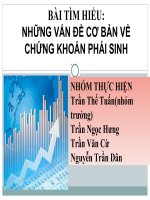Chứng khoán phái sinh Tiếng Anh
Bạn đang xem bản rút gọn của tài liệu. Xem và tải ngay bản đầy đủ của tài liệu tại đây (107.86 KB, 3 trang )
Name: Vũ Thị Hải
Student’s ID: 11181456
Class: Advanced Finance 60C
DERIVATIVES – MID-TERM TEST
Question 1:
A derivative is an instrument that derives its value from an underlying asset. The
underlying asset can be in the form of equity, interest rate, commodities or even currency.
Derivatives are used to hedge aganist various types of risk that help the firm to share risk
and invest in projects with relatively higher risk. In term of sharing risk, according to
Rajesh Kumar, in Strategies of Banks and Other Financial Institutions, 2014, financial
institutions and corporations use derivative financial instruments to hedge their exposure
to different risks, including commodity risks, foreign exchange risks, and interest rate
risks. Basically hedging consists of taking a risk position that is opposite to an actual
position that is exposed to risk. A company that takes variable-interest, short-term loans
or that reissues commercial paper as it matures faces interest rate risk. In such cases, the
firm might hedge its position by entering into a transaction that would produce a gain of
almost the same amount as the potential loss if interest rates do increase. Forwards,
futures, and options can be used to hedge exposure to the effects of changing interest
rates. Foreign exchange futures contracts can be used by firms to hedge foreign exchange
risks. Interest rate swaps, which form a major chunk of derivatives, is used to hedge
interest risk. In interest rate swaps, the fixed interest payments are exchanged for floating
rate payments or vice versa without exchanging the underlying principal amounts.
Derivatives hedging techniques using interest rate swaps and interest rate caps can help
institutions retain core longer-duration assets to manage interest rate risk. A business that
must buy a commodity in the future is exposed to the risk of a rapid increase in the price
of that commodity. A “futures” contract—a common derivative—can be used to reduce
risk exposure to volatile commodity prices. When you buy a commodity futures contract
you agree (today) to the price that you will pay to take delivery of a commodity in the
future. The seller of the contract is obligated to deliver the commodity on a specified date
in the future for that price. The future could mean a few months or a few
years. Commodity futures contracts are traded on regulated exchanges. Trading
commodity futures on organized exchanges dates back to Japanese rice exchanges in the
17th century. Then and now, the exchange specifies the quantity and quality of the
physical commodity that the futures contract is based on. “Forwards” are very similar to
futures, but they are not traded on exchanges. They are traded over-the-counter (OTC)
between two parties who may customize the forward contract to meet their specific
risks. In addition, one of the more common corporate uses of derivatives is for hedging
foreign currency risk, or foreign exchange risk, which is the risk a change in currency
exchange rates will adversely impact business results. Companies depending heavily on
raw-material inputs or commodities are sensitive, sometimes significantly, to the price
change of the inputs. Airlines, for example, consume lots of jet fuel. Historically, most
airlines have given a great deal of consideration to hedging against crude-oil price
increases. For instance, Monsanto produces agricultural products, herbicides, and biotechrelated products. It uses futures contracts to hedge against the price increase of soybean
and corn inventory: Monsanto uses futures contracts to protect itself against commodity
price increases...these contracts hedge the committed or future purchases of, and
the carrying value of payables to growers for soybean and corn inventories. A 10 percent
decrease in the prices would have a negative effect on the fair value of those futures of
$10 million for soybeans and $5 million for corn. We also use natural-gas swaps to
manage energy input costs. A 10 percent decrease in the price of gas would have a
negative effect on the fair value of the swaps of $1 million. Furthermore, stock equity
options—another common derivative—can be used to increase or decrease exposure to
the risk of rapidly fluctuating stock market prices. There are two types of option
contracts: “calls” and “puts”. The owner of a call option owns the right, but not the
obligation, to buy an asset at a specified price (known as the option’s strike price) by a
specific date in the future. For example, the $400 Amazon.com April 2014 call option
would give the option owner the right, but not the obligation, to buy Amazon.com stock
for $400 between now and April. Call options rise in value when the underlying stock, in
this case Amazon.com, rises. The owner of a put option owns the right, but not the
obligation to sell an asset at a specified strike price by a specified date in the future. The
April 2014 $330 Amazon.com put option would give the holder the right, but not the
obligation, to sell Amazon stock for $330 between now and April. Puts rise in value
when the underlying stock falls. Options trade on regulated exchanges, like the Chicago
Board of Options Exchange, the Chicago Mercantile Exchange, and the International
Securities Exchange. Options also trade over-the-counter, away from regulated
exchanges.
High-risk investments that may have potential for significant gains (or losses). Buyand-hold investors generally make money when the stocks they’ve invested in go
up in price. The benefits of derivatives also apply to investment risks. A pension
fund manager with a large portfolio of corporate bonds can protect the value of
their portfolio by entering into a derivative contract. Executing a derivative trade
that increases in value as prices in the bond market fall will allow a manager to
steady investment returns, and reduce losses in periods of short-term volatility.
Question 2: The correct answer is B. is an agreement to buy or sell a specified
amount of an asset at a predetermined price on the expiration date of the contract.
Future contract is an agreement to buy or sell a specified amount of an asset at a
predetermined price on the expiration date of the contract.
Particularly, in a futures contract, two parties agree that one party (buyer) will
purchase an underlying asset from the other party (seller) at a future date and
fixed price they agree on when the contract is signed. The buyer of a futures
contract is taking on the obligation to buy and receive the underlying asset when
the futures contract expires. The seller of the futures contract is taking on the
obligation to provide and deliver the underlying asset at the expiration date.
Question 3: The correct answer is B. $5,500 profit
The profit per ounce: $4.10 - $3.00 = $1.10
The profit of the contract: $1.10 * 5,000 = $5,500.









